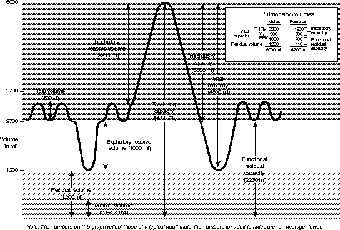Anatomy and Physiology: Volumes and Volumes
Volumes and Volumes
To truly understand breathing, it is necessary to look at the pulmonary volumes and capacities (see Figure 13.9). The in and out of normal breathing takes place within the tidal volume, whose name makes perfect sense since tides also go in and out. That alone might be enough, except for the fact that you sometimes need to either take in, or release, extra air.
A simple cough demonstrates this very easily. If you have ever inhaled enough dust to irritate your lungs, the incredible urge to cough takes over. If, however, you only had a tidal volume, you would have no hope of ever being able to get rid of the irritation. The expiratory reserve volume allows you to force the dust out by applying far more pressure behind the dust than there is in front of it.

Figure 13.9Your normal breathing is your tidal volume, but reserve volumes necessary to your survival increase your total lung capacity.
The residual volume is well known if you have ever had the wind knocked out of you. The uncomfortable sensation of struggling to take your first breath afterward is due to the fall forcing out the residual volume. The residual nature of that volume prevents you from having to inflate a fully deflated lung with every breath; this is just like the way a balloon is easier to blow up after it has a little air in it.
Medical Records
Imagine having to re-inflate your lungs with every breath! Premature babies have this very problem if they are born before the eighth month. If you have ever tried to float a paper clip on fresh water, you have seen the effect of surface tension. Adding dish soap breaks the surface tension, causing the paper clip to sink. The surface tension of the water in the lungs has the effect of collapsing the roughly spherical alveoli. Surfactant, a protein that starts being produced in the ninth month, breaks the surface tension, allowing the alveoli to stay open.
Swimming would not be possible without inspiratory reserve volume, which allows you to inhale well beyond your tidal volume. This enables you to hold your breath by taking in extra air. This also explains why the first desire when holding your breath is to release the breath you had been holding! This brings up an important point. We have always been told of the primary importance of getting oxygen; equally important, however, is the need to get rid of carbon dioxide. As you will see, the buildup of carbon dioxide is crucial to the regulation of your breathing.
Controlling Breathing
Have you ever thought about how often you breathe? Adults breathe about 12 to 18 times a minute, while children tend to breathe 18 to 20 times a minute. If you imagine breathing in 500 ml of air on a normal tidal volume, then, at 12 times a minute—12 × 500 ml = 6000 ml = 6 liters—you are breathing 6 liters of air (three 2-liter bottles) every minute. Of the 500 ml in each breath, only 350 ml actually reach the alveoli. As a result, the alveolar ventilation is less: 12 × 350 ml = 4200 ml = 4.2 liters a minute. That might not be enough to meet your gas exchange needs, so your brain must have a way to change the rate you breathe.
To understand how the brain controls breathing, you need to remember a little about pH, or the powers of hydrogen. As I mentioned earlier, O2 is carried mainly in the hemoglobin of red blood cells (RBCs), and CO2 is carried mainly in blood plasma, which is mostly water. The interaction of the CO2 and the water can be seen in the reversible reaction below:
- CO2 + H2O H2CO3 H+ + HCO3-
- carbonic acid
Whenever cells use up the O2 in cellular respiration, and thus release CO2, your blood pH changes. With the addition of the H+ ions, the blood becomes acidic.
Blood pH must remain within a narrow range; if the pH strays too far from neutral (pH 7), enzymes will fail to function. There is a word for that condition: death! As such, o by monitoring the brain must carefully monitor the CO2 levels, and it does spH. The brain does so in the respiratory centers of the medulla oblongata, where the brain and the brain stem meet.

Excerpted from The Complete Idiot's Guide to Anatomy and Physiology © 2004 by Michael J. Vieira Lazaroff. All rights reserved including the right of reproduction in whole or in part in any form. Used by arrangement with Alpha Books, a member of Penguin Group (USA) Inc.
To order this book direct from the publisher, visit the Penguin USA website or call 1-800-253-6476. You can also purchase this book at Amazon.com and Barnes & Noble.







